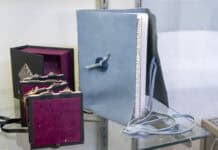After many hours of discussion over the last few months, the Sedona City Council voted on what the updated sign code will look like.
While the code covers a range of topics regarding signs, the most talked about aspect has been that of offpremise temporary signs and what can and can’t be allowed under a Supreme Court ruling.
On Tuesday, Sept. 26, council voted 6-1 in favor of the draft revised sign code. Councilman Tom Lamkin was the dissenting vote, saying he was in favor of banning all off-premises signs.
“Staff has done a good job of trying to come up with some reconciliation between the original recommendation [to ban all offpremise signs] and trying to come up with a win-win that in my opinion is not a win-win,” Lamkin said. “I would hope that council would think it through. We’re taking this on faith that policing will occur and everyone will follow the law. It’s not happening now and everyone already knew it was illegal.”
The city has been working on an update to the sign code for the past two years. It was also identified as a council priority several years ago. A few months into the update process, the project was put on hold due to a U.S. Supreme Court case involving how cities may regulate signs [Reed v. Town of Gilbert]. Essentially, the court stated that a city cannot regulate signs based on the content of a sign but can regulate such things as location, height, material, lighting, size and function.
Prior to council’s vote, city code stated that the only off-premises signs that are allowed are for garage sales and real estate open houses. But due to the ruling, cities are now faced with an all-or-nothing scenario when it comes to these types of signs.
“I think we’ve done the best we can,” Mayor Sandy Moriarty said. “We cannot put this off forever — we have to pass something. Ordinances can be changed. But we have to pass some thing or we’re in jeopardy of being found to be not in compliance with the Supreme Court ruling.”
The code allows for the placement of wayfinding signs for uses such as open houses, garage sales and open studios. These signs would be managed through a sign permitting system and could be issued overthe-counter, similar to the current process for on-site temporary banner signs.
In those cases, the temporary banner signs, upon approval, are issued a temporary sign permit sticker that must be placed on the approved sign and aids in the enforcement of temporary signs.
The following regulations will apply to the specific temporary signs as indicated and subject to the issuance of a temporary sign permit:
- Up to four temporary signs may be placed either on the owner’s property or offsite for the purpose of directing the public when the property owner is opening the property to the public for a residential or nonprofit activity such as real estate open house, garage/yard sale or estate sale. A maximum of one sign may be located onsite and a maximum of three signs may be located off-site, with no more than one sign per turning movement.
- Signs may be displayed a maximum of 12 times per year.
- Signs may be displayed between the hours of 7 a.m. and 8 p.m.
- Signs shall not exceed three square feet in area and three feet in height.
- Signs shall not be illuminated.
- Signs shall not be placed so as to create a traffic hazard, as determined by city staff. Signs shall not be placed in ADOT rights-of-way, traffic medians, public sidewalks or bicycle paths.
- Signs may be placed in city of Sedona rights-ofway in residential districts, but shall not be attached to any trees, fences, utility poles, light posts, street signs or any other public facility located within city rights-of-way.
- Signs shall have sufficient weight and durability to withstand wind gusts, storms and other weather elements.
- Signs shall not be made of flimsy or unstable materials such as cardboard boxes, poster board or paper.
- Signs shall not have attachments, including, but not limited to, balloons, ribbons, loud speakers, etc.
- Signs may be placed on privately owned property in residential districts with the written permission of the property owner.
- Accepting payment or any form of compensation for the placement of off-premise signs is prohibited.
- Temporary signs in residential districts shall be used only for wayfinding purposes.
- Violations are subject to any and all adopted fees and enforcement policies and regulations.
In addition, temporary off-premises signs in commercial districts are prohibited except for temporary wayfinding signs for nonprofit or residential activities which are permitted occurring adjacent to commercial districts.
Council also discussed an intergovernmental agreement the city has with the Arizona Department of Transportation in terms of state routes 89A and 179. Currently ADOT does not allow any off-premise signs in its rights of way.
Through the agreement, the city is in charge of many aspects of the roadway including maintaining sidewalks, bike lanes, markings, street sweeping and the removal of all off-premise signs. The agreement with ADOT was signed in 2007.
Council wishes to address the matter at a future date to see if the city’s updated sign code can also apply to the state’s rights-of-way.


















